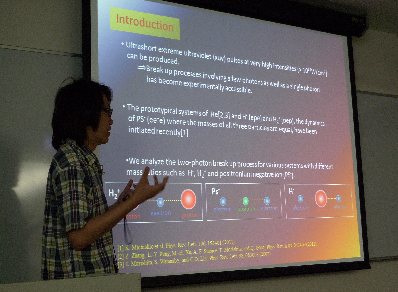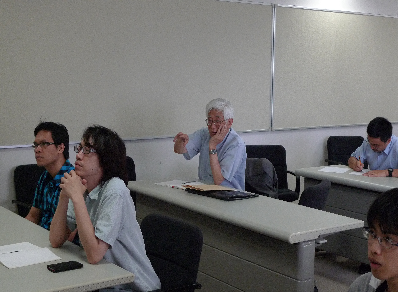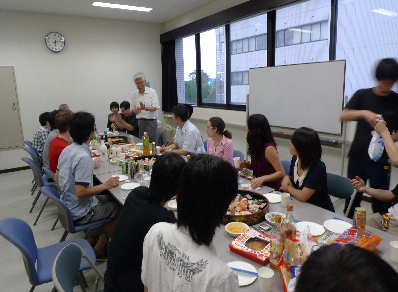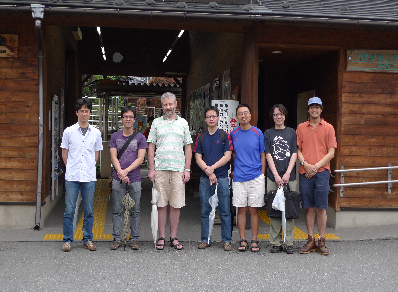International workshop on theory for attosecond quantum dynamics
(IWTAQD) 5

June 25 -July 13, 2012

Diection
to UEC
English,
Japanese




more photos
Participants (Bldg. E-6, Rms. 525, 527)
| Oleg I. Tolstikhin |
Kurchatov Institute &
MIPT
|
Adiabatic Theory
|
June 25 -July 13, 2012 |
| Chiennan Liu |
Fu-jen University |
He dynamics under FEL |
June 25 -July 12, 2012 |
| Yasuo Okajima |
Nara Inst Sci & Tech
|
HHG |
Jan 29-July 3, 2012
|
| Erik Loetstedt |
RIKEN |
Moleular dynamics
|
July 5, 2012 |
| Kenichi Ishikawa |
U of Tokyo |
He dynamics |
July 5, 2012 |
| Takeshi Sato |
U of Tokyo
|
Multielectron molecular
dynamics
|
July 5, 2012 |
| Linda Hamonou |
UEC |
Tunnel ionization of
molecules
|
June 25 -July 13, 2012 |
Michio Matsuzawa
|
UEC
|
|
July 5, 2012 |
Shinichi Watanabe
|
UEC |
|
June 25 -July 13, 2012 |
| Toru Morishita |
UEC
|
Chair
|
June 25 -July 13, 2012 |
| Hsumin Hoang |
UEC |
3-body break up |
June 25 -July 13, 2012 |
| Masataka Ohmi |
UEC |
TDSE |
June 25 -July 13, 2012 |
| Vinh Trinh Hoai |
UEC |
Tunnel ionizatoin |
June 25 -July 13, 2012 |
| Vinh Pham Nguyen Thanh |
UEC |
Rescattering |
June 25 -July 13, 2012 |
Tomotake Yanakoshi
|
UEC |
Cold atoms |
June 25 -July 13, 2012 |
Osamu Ban
|
UEC |
Cold atoms |
June 25 -July 13, 2012 |
Roichi Saito
|
UEC |
Tunnel ionizatoin |
June 25 -July 13, 2012 |
Takahiro Ohwada
|
UEC |
|
June 25 -July 13, 2012 |
Jun Ajiro
|
UEC |
|
June 25 -July 13, 2012 |
Tadayuki Yamaguchi
|
UEC |
|
June 25 -July 13, 2012 |
Satoshi Toge
|
UEC |
|
June 25 -July 13, 2012 |
Shun Ohgoda
|
UEC |
|
June 25 -July 13, 2012 |
Chiharu Kohari
|
UEC |
|
June 25 -July 13, 2012 |

Seminar Program
July 5
(Thr) 14:30- 17:00
' Laser-atom/molecule interactions & Photon creation'
Place: Bldg. East 6, Rm. 803
Chair : T. Morishita
14:30-14:50
SPEAKER: Hsumin Huang, UEC
TITLE: Two-photon
break up of collinear Coulomb three-body systems by ultrashort
intense laser pulses
ABSTRACT:
We theoretically study two-photon break up dynamics of collinear
Coulomb three-body systems interacting with ultrashort intense laser
pulses. Here both nonlinear light-matter interactions and particle
correlations play important roles. By analyzing the break up
momentum distributions for various systems which have different mass
ratios such as H-, H2+ and Ps-, we identify sequential and
no-sequential process and found that different kinds of break up
dominates in different systems.
14:50-15:30
SPEAKER: Erik Loetstedt, RIKEN
TITLE: Triple
Compton effect: A photon splitting into three after collision with
a free electron.
ABSTRACT:
The process in which a photon inelastically scatters off a free
electron is called Compton scattering, and is well known. Perhaps
less familiar are the higher-order Compton processes, where the
incoming photon is split into two or more photons. Some recent
results on the triple Compton effect, with three photons in the
final state, will be presented. Of particular interest is that the
polarizations of the three final photons are quantum mechanically
correlated.
15:30-15:40 Break
15:40-16:20
SPEAKER: Takeshi Sato,
University of Tokyo
TITLE:
Multiconfigurational wavefunction approaches to electron
dynamics in intense laser fields
ABSTRACT:
We are developing flexible time-dependent multiconfigurational
wavefunction methods for correlated electron dynamics in intense
laser fields.
In this talk, I will discuss on the generalized valence-bond
(GVB) as a simplest possible wavefunction for describing
intense-field ionizations.
Numerical applications of GVB and related techniques to 1-D
models will be presented.
Theoretical framework in multi-electron (beyond-two) systems
will be briefly discussed.
16:20-17:00
SPEAKER: Oleg I. Tolstikhin,
National Research Center "Kurchatov Institute" & Moscow
Institute of Physics and Technology, Moscow, Russia
TITLE: Adiabatic
theory of ionization of atoms by intense laser pulses
ABSTRACT:
In the laser-atom interaction problem, the adiabatic
approximation applies for sufficiently long wavelengths uniformly
with respect to the amplitude of the laser field. A review of the
first steps in the development of the adiabatic theory of ionization
of atoms by intense laser pulses will be presented. The Keldysh
theory and so-called strong field approximation is only a weak-field
limit of the adiabatic theory.
17:00-
Free discussion, Rm 529
July
9 (Mon) 14:40- 15:40
'Tutorial talk'
Place: Bldg. East 6, Rm. 803
Chair : T. Morishita
14:40-15:40
SPEAKER: Oleg I. Tolstikhin,
National Research Center "Kurchatov Institute" & Moscow
Institute of Physics and Technology, Moscow, Russia
TITLE: Retardation in electrodynamics and adiabatic
theory.
ABSTRACT:
We all know what is the retardation in electrodynamics. The
development of the adiabatic theory of ionization of atoms by
intense laser pulses has revealed a similar (but not identical)
phenomenon. I will try to explain the similarity and differences.

Toru Morishita,UEC




